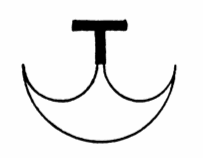Arbelas

The arbelas (plural arbelai) was a type of ancient Roman gladiator. The word is a hapax legomenon, occurring only in the Oneirocritica of Artemidorus, a Greek work on dream interpretation that discusses the symbolism of various gladiator types.[1] It may be related to the Greek word arbelos (ἄρβηλος), a cobbler's semicircular blade used to cut leather[1][2][3] similar to an ulu.
A few reliefs show gladiators armed with a curved blade fighting each other; it has been argued that these (possibly also fighting retiarii, the net-fighters) are arbelai;[3] however, they have also been seen as the scissores who likewise may have been matched against retiarii.[2][4] The scissor, with whom the arbelas may be synonymous, is referred to in a roll call from the gladiator training school (ludus) owned in the 1st century BC by the lanista C. Salvius Capito.
Artemidorus lists the arbelas among gladiators who might appear in dreams advising a man about what sort of woman he is to marry. Both the dimachaerus, who fought with two curved blades, and the "so-called" arbelas signify that the woman will either be a poisoner, malicious, or ugly.[3][5]
References
- 1 2 Duncan, Anne (2006). Performance and Identity in the Classical World. Cambridge University Press. p. 205.
- 1 2 Fagan, Garret G. (2011). The Lure of the Arena: Social Psychology and the Crowd at the Roman Games. Cambridge University Press. p. 217.
- 1 2 3 Carter, Michael (2001). "Artemidorus and the Arbelas Gladiator". Zeitschrift für Papyrologie und Epigraphik. 134: 109–115. JSTOR 20190801. (subscription required)
- ↑ Carter, Michael (2006). "Gladiatorial Combat with 'Sharp' Weapons (τοι̑ϛ ὀξέσι σιδήροιϛ)". Zeitschrift für Papyrologie und Epigraphik. 155: 161–175. JSTOR 20191036. (subscription required)
- ↑ Carter, Michael (2008). "(Un)Dressed to Kill: Viewing the Retiarius". In Edmondson, J. C.; Keith, Alison. Roman Dress and the Fabrics of Roman Culture. University of Toronto Press. p. 129.